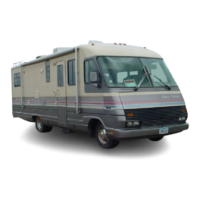3.
4.
5.
Drive
the
vehicle
backward
until
the
tag
axle
wheels
just
clear
the
scale pad.
It
is
important
to
keep
the tag
and drive wheels level
for
ac-
curacy.
This
is
the
load on
the
drive and
front
axles
(Reading 3).
Subtract
Reading 2
from
Reading
1.
This is
the
front
axle
weight
(Front GAW).
Subtract
Reading 3
from
Reading
1.
This is the tag axle
weight
!Tag GAW).
Subtract
front
GAW
from
Reading
3.
This
is
the
drive axle
weight
(Drive
GAW).
Compare
the
Gross Vehicle
Weight
(Reading
1)
to
the
GVWR (Gross Vehicle
Weight
Rating)
of
your
vehicle.
If
this
weight
exceeds
the
GVWR
of
your
vehicle,
you
will
have
to
remove cargo
to
reduce
the
total
vehicle load.
6.
Compare
each axle
weight
to
its respective
GAWR
(Gross
Axle
Weight Rating).
If
any
axle
weight
exceeds
its
rating,
you
will
have
to
redistribute
cargo
to
insure
that
the
load on
each axle is
within
its required limit.
7.
The
motor
home
should also be
weighed
from
side
to
side. This
will
require
positioning
all
wheels
on
each side
down
the
center
of
the
scale
platform
and taking a reading
for
each
side. The
attendant
will
help you
with
proper
positioning.
PeJiodically
re-weigh
your
motor
home.
Different
traveling
configurations
may
change
your
loading and
weight
pattern.
.
WARNING: DO NOT EXCEED THE RATED LOAD
OF
THE
MOTOR HOME,
OR
THE RATED LOAD
OF.ANY
AXLE.
NOTE: THE PASSENGER
AND
CARGO CARRY-
ING CAPACITIES OF YOUR MOTOR HOME ARE
SPECIFIED ON A LABEL AFFIXED
TO
THE IN-
SIDE OF A WARDROBE DOOR.
THE
LABEL IN-
CLUDES
ALL
FACTORY INSTALLED OPTIONS.
IF OTHER EQUIPMENT SUCH AS LEVELING
JACKS, AWNINGS, ROOF PODS, ETC., ARE IN-
STALLED AFTER THE MOTOR HOME LEAVES
THE FACTORY,
THE
WEIGHT
OF
THESE ITEMS
MUST
BE SUBTRACTED FROM THE TOTAL OF
THE PASSENGER
AND
CARGO CARRYING
CAPACITIES.
Loading
Tips
After
you
have
determined
how
much
weight
you
can
safely
carry
and selected those
items
to
make
up
that
weight,
make a
list
and keep
it
for
future
reference. Load
the
motor
home and
distribute
the
load so
that
you get proper weight on the axles.
Don't
load heavy
items
in
upper
cabinets. Secure and brace
items so
they
won't
move during travel, thereby shif-
ting
motor
home
load. Do
not
load heavy items near
either
end
of
the
motor
home
or on the rear bumper.
Adjust
cargo
storage to keep the side to side wheel
loads
as
equal
as
possible. Carry
only
as
much
water
15
as needed 'for travel use
or
to
balance
the
load.
Whenever possible,
empty
the
holding
tanks before
traveling.
WARNING: MODIFICATION
OF
YOUR VEHICLE
BY ADDITION
OF
RACKS NOT SPECIFIED
BY
THE MANUFACTURER
TO
CARRY
ADDITIONAL
EQUIPMENT
OR
VEHICLES
IS
NOT
RECOMMENDED.
Make a loading diagram
of
your
properly
loaded
motor
home.
It
will
help
you
locate
where
specific
items are stored, and
will
help speed
the
loading pro-
cess. Store emergency
items
in
a readily accessible
location. Include a fire extinguisher, tools,
jack,
first-
aid kit, rain gear, flashlight,
highway
warning
devices,
and
an
electric cord
with
light.
WARNING: DO NOT STORE OR CARRY
LP
GAS
CONTAINERS, GASOLINE, OR OTHER
FLAM-
MABLE LIQUIDS INSIDE YOUR MOTOR HOME.
TRAILER HITCHES
AND
TOWING
If you expeCt to pull a trailer
with
your
motor
home,
please use these guidelines
when
choosing
a
hitch
and trailer:
•
•
•
•
Hitch classification: Class
II
Limit
the
vertical
hitch
load
(tongue
weight
of
trailer)
to
a
maximum
of
250
pounds. Heavier
vertical
hitch
loads can cause
damage
to
your
motor
home rear frame and body, cause
unstable driving and handling
characteristics,
and
may
restrict
your
rights
under the
Owner-
care warranty.
Do
not
tow
a trailer
weighing
more
than
3500
pollnds,
or
more
than
recommended
by
the
chassis
manufacturer
(as
described
below),
whichever is less. Heavier trailers can cause
damage
to
the
motor
home
structure
or
drive
train, cause
unstable
driving
or
handling
characteristics, or restrict your rights
under
the
Dwnercare warranty.
Check
the
following
chart
to
determince
the
Gross Combined Weight Rating (GCWR)
of
the
motor
home chassis. The GCWR is the
total
weight
of
the
motor
home and trailer.
Chassis
Axle
Manufacturer Engine Ratio GCWR
•
Chevrolet 7.4L
(454)
V8
GAS
4.56
19,000
Chevrolet
4.88
19,000
Oshkosh
(460)
VB
Gas
EFI
4.88
20.000
Ford
(460)
V8
Gas
EFI
5.13
25,000
Alternate. gear ratios may
be
retrofitted
for
special
towing
needs.
Contact
your
local
chassis
manufacturer
dealer
for
recommenda-
tions. Exceeding these GCWR's
may
cause
damage
to
your
motor
home drive train or
chassis.
unstable
driving
and
handling
characteristics,
and
may
void
your
warranty.

